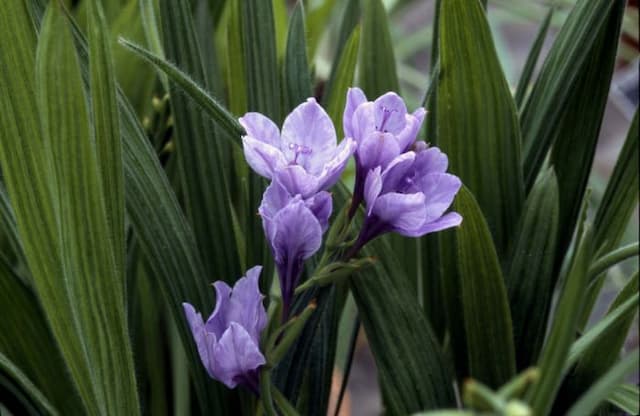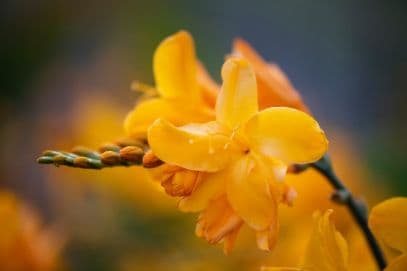Tall Bearded Iris Iris 'Morwenna' (TB)

ABOUT
Iris 'Morwenna' is a type of Tall Bearded Iris, which is known for its elegant and strikingly beautiful flowers. The blooms of 'Morwenna' are characterized by their distinct color combination and form. Each flower consists of six petal-like structures: three upright standards and three downward hanging falls. The standards typically exhibit a light color, providing a delicate contrast to the more vividly colored falls. The falls are often adorned with intricate veining or patterning and may have a soft gradient of hues that blend seamlessly from one to another. The colors in 'Morwenna' can range from deep, rich shades to lighter pastels, encompassing purples, blues, yellows, or whites, often with a vibrant, contrasting beard that adds a dash of complementary or striking color. The leaves of Tall Bearded Irises like 'Morwenna' are long, slender, and sword-shaped, forming dense clumps that originate from the base of the plant. The foliage is typically a deep, glossy green, which forms an attractive backdrop to the showy flowers. The plant blooms in late spring to early summer, displaying its flowers atop sturdy, upright stems that emerge from the clump of foliage. The overall impression of an Iris 'Morwenna' is one of classic beauty and sophisticated charm. With its dramatic flowers and stately presence, it is a favorite among gardeners and is often used as a standout feature in garden borders, beds, or as a focal point in floral arrangements.
About this plant
 Names
NamesSynonyms
Tall Bearded Iris, Bearded Iris
Common names
Iris 'Morwenna' (TB).
 Toxicity
ToxicityTo humans
The Iris 'Morwenna' (TB), commonly known as a type of Bearded Iris, is considered to have low toxicity to humans. However, all parts of the plant, especially the rhizomes (underground stems), can cause irritation if ingested. Eating large quantities might lead to digestive discomfort, nausea, vomiting, and diarrhea. Handling the plant may also cause skin irritation in sensitive individuals. It is advisable to avoid ingesting any part of the Bearded Iris and to wash hands after contact.
To pets
The Bearded Iris, including the Iris 'Morwenna' (TB), is considered to have low to mild toxicity to pets such as dogs and cats. Ingesting parts of this plant, particularly the rhizomes, can cause gastrointestinal upset, evidenced by symptoms like drooling, vomiting, and diarrhea. While it is unlikely to be life-threatening, ingestion can be uncomfortable for the animal and it's best to prevent pets from accessing the plant. If a pet does consume part of a Bearded Iris, monitoring for symptoms and contacting a veterinarian is recommended.
 Characteristics
CharacteristicsLife cycle
Perennials
Foliage type
Deciduous
Color of leaves
Green
Flower color
Mixed
Height
2-3 feet (60-90 cm)
Spread
1-2 feet (30-60 cm)
Plant type
Bulb
Hardiness zones
3-9
Native area
Europe
Benefits
 General Benefits
General Benefits- Aesthetic Appeal: The Iris 'Morwenna' adds striking beauty to gardens with its large, ruffled flowers and vibrant coloration.
- Attracts Pollinators: This tall bearded iris variety attracts bees and butterflies, which are essential for pollinating many plants and crops.
- Drought Tolerance: Once established, the Iris 'Morwenna' is relatively drought-resistant, making it suitable for xeriscaping or gardens in drier climates.
- Low Maintenance: Being a hardy perennial, it requires minimal care once it is established, making it ideal for gardeners of all skill levels.
- Seasonal Interest: The Iris 'Morwenna' typically blooms in late spring, providing a seasonal display of color and interest in the garden.
- Boundary Definition: These plants can be used in borders or as natural dividers in the garden landscape due to their upright growth habit.
- Cut Flowers: Flowers from the Iris 'Morwenna' make excellent cut flowers for arrangements with their stunning appearance and long vase life.
 Medical Properties
Medical PropertiesThis plant is not used for medical purposes.
 Air-purifying Qualities
Air-purifying QualitiesThis plant is not specifically known for air purifying qualities.
 Other Uses
Other Uses- Crafting natural dyes - The petals of the Iris can be used to create natural dyes for fabrics, yielding various shades of blue, purple, and even green depending on the mordant used.
- Fine art - The unique patterns and colors of the Iris flowers can inspire botanical illustrations and other forms of plant-based artwork.
- Garden design - Irises are often used in garden design for their vertical accent and can be planted along borders or as focal points in a garden bed.
- Floral perfumery - While not traditionally known for scent, some Iris varieties can contribute subtle fragrances to floral perfumes.
- Eco-printing - Iris petals and leaves can be used in eco-printing techniques to transfer their shapes and colors onto paper or textiles.
- Decorative potpourri - Dried Iris petals can be added to potpourris for visual appeal and a mild natural scent.
- Photography subject - The distinctive shape and vibrant colors of Irises make them an excellent subject for macro and garden photography.
- Edible garnishes - Some parts of certain Iris species are edible and can be candied or used fresh to decorate desserts and dishes, although caution is advised as many species can be toxic.
- Symbolic uses - Irises carry symbolic meanings in various cultures, such as eloquence and messages, and are used in ceremonial occasions to convey these sentiments.
- Water purification - Iris plants are used in water gardens and natural clean-up processes because they can help filter and clean water bodies by absorbing pollutants (although this is not specifically a use for the 'Morwenna' variety).
Interesting Facts
 Feng Shui
Feng ShuiThe Iris is not used in Feng Shui practice.
 Zodiac Sign Compitability
Zodiac Sign CompitabilityThe Iris is not used in astrology practice.
 Plant Symbolism
Plant Symbolism- Faith: The iris often symbolizes faith and hope, with its elegant and upright petals reaching towards the sky.
- Wisdom: Throughout history, irises were associated with wisdom and valued for their distinctive look which was seen as representing intelligence and knowledge.
- Courage: In some cultures, the iris represents courage, inspired by the flower's bold colors and strong presence in a garden.
- Purity: The iris, particularly in white, denotes purity and innocence, often used in bridal bouquets or religious ceremonies.
- Royalty: Its regal appearance has made the iris a symbol of royalty and noble bearing, linked to various monarchies and ruling classes.
- Hope: As a harbinger of spring, the iris is seen as a symbol of new beginnings and the hope that accompanies the season's arrival.
 Water
WaterTall Bearded Irises, like the Iris 'Morwenna,' need to be watered deeply but infrequently to promote deep root growth. During the growing season, watering once a week with about a gallon of water per plant should suffice, depending on the soil and climate conditions. Bearded Irises require less water once they are established and can tolerate dry conditions. In the absence of rainfall, maintain consistent watering but allow the soil to dry out between watering sessions to prevent root rot.
 Light
LightThe Tall Bearded Iris thrives in full sun. It prefers a spot in the garden that receives at least six hours of direct sunlight per day. However, in extremely hot climates, providing light afternoon shade can help protect the blossoms from fading or scorching. Avoid planting in areas where tall trees or buildings will shade the Iris 'Morwenna' for most of the day.
 Temperature
TemperatureTall Bearded Iris 'Morwenna' can tolerate a wide range of temperatures but grows best when the daytime temperature is between 55 and 75 degrees Fahrenheit. They can survive winter cold down to about -20 degrees Fahrenheit and summer highs up to 90 degrees Fahrenheit. Irises require a period of cold dormancy in winter to bloom successfully in the spring.
 Pruning
PruningPruning of Tall Bearded Irises, such as Iris 'Morwenna,' involves removing the spent flowers just below the bloom to tidy the plant and prevent seed formation. After blooming, cut the entire flower stalk down to the base to divert energy back into the rhizome for next year's growth. Prune back the foliage to about 6 inches in the fall to minimize overwintering pests and diseases and to reduce wind resistance during winter storms.
 Cleaning
CleaningAs needed
 Soil
SoilTall Bearded Irises, including 'Morwenna', thrive in a well-draining, loamy soil with a pH of 6.8 to 7. The best soil mix should consist of two parts loam, one part peat moss, and one part perlite or coarse sand to ensure proper drainage and aeration. Avoid heavy, soggy soils as these can lead to rhizome rot.
 Repotting
RepottingTall Bearded Irises like 'Morwenna' don't need regular repotting as they are typically grown outdoors. However, to maintain vigor and bloom quality, divide and replant these irises every 3 to 4 years, ideally after the flowering season in summer. This helps prevent overcrowding and rejuvenates the plants.
 Humidity & Misting
Humidity & MistingTall Bearded Irises, including the 'Morwenna' variety, are adaptable to a wide range of humidity conditions and do not require high humidity. They will perform well in the typical outdoor humidity levels found across their growing zones. It is more important to ensure good air circulation around the plants to prevent disease.
 Suitable locations
Suitable locationsIndoor
Ensure full sun, well-draining soil, limited watering.
Outdoor
Plant in full sun, well-drained soil; provide ample space.
Hardiness zone
3-9 USDA
 Life cycle
Life cycleThe Iris 'Morwenna' (Tall Bearded Iris) life cycle begins with seed germination, although commercial cultivation is more commonly through rhizome division. The rhizome, once planted, develops roots and shoots. As the plant matures, sword-like leaves emerge, typically in a fan-like pattern. In the flowering stage, which occurs in late spring to early summer, the Tall Bearded Iris produces showy flowers on tall stems, which may need support to prevent them from bending or breaking. After flowering, the plant enters a period of vegetative growth, where it stores energy in the rhizome for the next season. Come fall, the foliage dies back, and the iris enters dormancy during winter, only to resume growth with the return of warm weather in spring.
 Propogation
PropogationPropogation time
Late summer
The most popular method for propagating the Tall Bearded Iris 'Morwenna' involves division, which is best done in late summer, typically several weeks after blooming has finished. This period usually falls between July and September. To propagate through division, carefully dig up the iris clumps and gently separate the rhizomes by snapping them apart at the natural break points. Each piece should have at least one fan of leaves and a section of the rhizome with healthy roots. Trim the leaves into a fan shape about 4 to 6 inches (10 to 15 centimeters) tall to reduce moisture loss and plant the rhizomes shallowly, with the top just visible above the soil surface, spacing them about 12 to 24 inches (30 to 60 centimeters) apart to allow for adequate growth. Water them in well to help settle the soil around the roots. This method encourages rejuvenation of the plants and helps to maintain the vigor and blooming potential of the irises.









